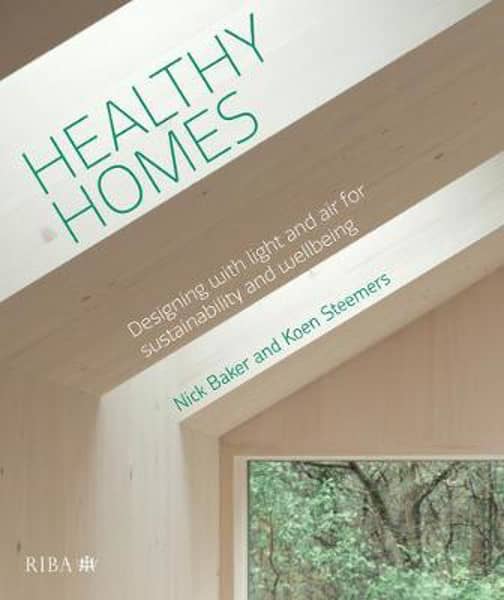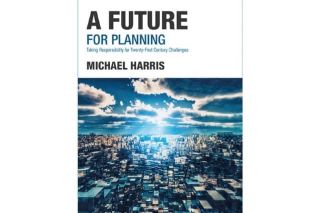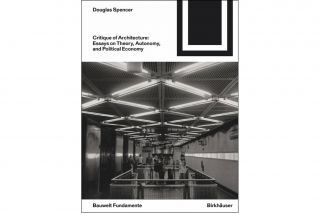
www.buildingsandcities.org/insights/reviews/healthy-homes-review.html
Healthy Homes: Designing with Light and Air for Sustainability and Wellbeing
By Nick Baker & Koen Steemers. RIBA Publishing, 2019, ISBN: 9781859467138
Christhina Candido reviews this book which explores how the design of indoor environments can be designed for human health and wellbeing.
Many of us have had to rethink our homes as a result of Covid-19 pandemic-induced restrictions and lockdowns. School and office closures meant that living rooms were turned into classrooms, daycare centres, and workplaces. Restrictions around access to restaurants and other venues meant that take away food was enjoyed amidst books and laptops in dining rooms. With so many spending most of their time indoors and at their homes, it was only natural to rethink the quality of space, including daylight, greenery, and furnishing, but also becoming more aware of how the overall design, performance and experience of spaces may have an impact on human health. In this context, this book makes a timely contribution to the built environment and health research and the community more broadly. Having access to the Healthy Homes book would be extremely beneficial to many trying to improve the design, experience and performance of their homes through an evidence-based approach. Students and industry professionals are likely to benefit from the technically driven content and applied nature of design examples. Members of the community may find the overview of aspects relevant to health and wellbeing within the residential context.
Healthy Homes aims to identify the key indoor environmental elements that have an effect on human health and wellbeing in residential buildings, with a view of informing design decisions. The book is extremely successful in achieving this goal, making a significant contribution to the dissemination of this type of content within a wider audience.
The book is concise, written in accessible
language and organised around just three sections intended to translate
rigorous research findings produced by the research community and the authors into
design solutions with the caveat of compromises that need to take place to make
solutions feasible. This angle and the introduction of 'compromises' is particularly
refreshing as they are often not so deliberately articulated in the literature.
This strategy also highlights the real challenges faced by designers and
architects when making decisions and their role in turning them into
opportunities. This subtly nods to the role that experts play in achieving a
high-performing built environment. It is also an important message deserving
amplification, especially considering the post-2020 events around the globe.
From bushfires to pandemic, 2020 has placed the societal challenges under the
spotlight along with strong link between human health and climate change. As
such, the timing of the Healthy Homes book is fortuitous.
Part one of the book has two chapters. Chapter
1 provides contextual information relevant to understanding the links between
health and housing, healthcare systems and a very interesting overview of
health science research through history. The authors introduce an overview of
key research topics and certification currently available, including mention of
the globally recognised and adopted International WELL Building Standard. WELL
is an evidence-based tool intended to improve people's health and wellbeing through
its holistic approach that includes seven concepts: air, water, nourishment,
light, fitness, comfort and mind. Once again, the summary provided in Chapter 1
is of particular value to students, practitioners and the community considering
how the global attention has shifted towards the topic post-2020.
Chapter 2 sharpens the focus of the book by introducing a definition for wellbeing which encompasses:
- health (the absence of disease)
- comfort (satisfaction with the environment)
- happiness (a state of
flourishing)
Providing this definition early in the book is important as a lack of universal agreement exists for what constitutes wellbeing. This clearly defines the authors' view about the topic and what the book is set to do. Despite the various definitions of wellbeing, going beyond health to include satisfaction and happiness makes sense, especially from a built environment perspective. This definition increases the need to embrace wellbeing as playing a central role on the design, experience and performance of spaces. As such, I welcome the definition articulated by the authors as it will once again help disseminate this important concept amongst built environment students and professionals.
The authors then detail 'Five Ways of Wellbeing': connect, keep active, take notice, keep learning and give. Then they proceed to explain how the built environment can influence these aspects. For 'connect', the authors explain the value of providing individuals and the community with everyday spaces for interactions that are attractive to pedestrians and with the added benefit of greenery. For 'keep active', the emphasis is on how the design of spaces may help individuals and the community to engage on physical activity of all intensities. Simple yet effective interventions in spaces, including art, vegetation and seating will help users to slow down and 'take notice' of surroundings. Meanwhile, spaces should be supportive to 'learning' activities but also help promote social and learning encounters. Finally, for 'give', a fascinating link is found between higher prevalence of self-reported altruistic behaviour and neighbourhoods, once again highlighting the value of space design to health. The design opportunities outlined at the end of this chapter are particularly useful to members of the community and industry in general with keen interest in links between human health and the built environment.
Part two focuses on technical information relevant to the overall performance of housing, from its surroundings to interiors. This part of the book is very relevant and useful to students and consultants in need of an overview of biophilic design, acoustics and microclimatic aspects that need to be considered when designing healthy homes. Chapter 3 provides an insightful account of the benefits of providing access to nature as part of the surroundings of residential buildings. Explaining the value of connecting with nature from a physical access point of view, sensorial considerations and actual direct contact and interactions through gardening and pets, for instance, is of particular value considering how residential buildings are used by people. Chapter 4 considers urban noise, outdoor generated noise and nuisances providing people with clear design solutions and performance recommendations needed to mitigate issues. Next, the focus shifts to perhaps a more 'traditional' but not less important aspect, which is microclimate, including reflections around urban heat island effect. Throughout, authors carefully map and articulate how design-related strategies can be used to mitigate the issues identified.
Chapter 5 focuses on external building envelopes, with a detailed overview of key aspects affecting the performance of spaces that can in turn have an impact on occupants' health and wellbeing. This shifts the attention to indoor environmental quality and building services. A detailed overview is provided of the fundamentals, applications and design considerations relevant to thermal comfort, ventilation, lighting (natural and artificial) and acoustics. This chapter focuses on classic research developed around indoor environmental quality performance, making a convincing effort to clearly articulate links between topics such as heating and cooling, circadian lighting, air pollution, mould growth and others and the contemporary thinking around human health and wellbeing. Light and air are part of the title of the book and the authors explain the health benefits arising from well ventilated and lit spaces and indoor air quality. Once again, the reader is provided with an overview of technical content with a view of applying it in practice. Some of the fundamentals, such as natural ventilation and access to daylight, are relevant to building typologies other than residential, which demonstrates the broader significance of the text.
The last section of the book is dedicated to translating the body of work covered in previous chapters into design strategies. Chapter 6 introduces what the authors call 'design scenarios' with the intention to illustrate how the fundamentals and overall technical content covered in previous chapters can actually be applied to the design of residential buildings. The eight design scenarios focus on low, medium and high-density developments, including also new, existing developments and a variety of residents. The structure adopted is very interesting, with each design scenario having the introduction of a specific brief, then progressing to the issue and proposed solutions. Solutions are not perfect and there is always a compromise, which adds to the authenticity of the proposed design scenarios in my view. The same approach is deployed for all eight scenarios which allows for further exploration from the reader around comparing different responses across proposed typologies.
This book provides a succinct and technically robust overview of key conceptual and technical aspects that combined may have a significant impact on health. In addition, it goes beyond the conceptual and technical aspects to actively engage with design aspects relevant to the practical application of the content. Examples or 'design scenarios' bring a special authenticity to this book. This is its main contribution, making a valuable and long-lasting addition to the literature that is of value to students, designers and the community more broadly. The authors final remarks centre around five key headings intended to also incite reflection:
- why the continuing debate?
- future proofing
- good enough design
- nudge architecture
- adaptive opportunity.
The authors close by connecting to the mantra originally coined by the RIBA president, Alex Gordon in the 1970s: 'long life, loose fit' which then progressed to 'long life, loose fit, low energy'. The authors argue that we should now add '…and healthy'. I think 2020 events have helped convince a significant portion of our society to adopt this mantra. For those still left unsure, I recommend reading the Healthy Homes book.
Latest Peer-Reviewed Journal Content
Net zero retrofit of the building stock [editorial]
D Godoy-Shimizu & P Steadman
Co-learning in living labs: nurturing civic agency and resilience
A Belfield
The importance of multi-roles and code-switching in living labs
H Noller & A Tarik
Researchers’ shifting roles in living labs for knowledge co-production
C-C Dobre & G Faldi
Increasing civic resilience in urban living labs: city authorities’ roles
E Alatalo, M Laine & M Kyrönviita
Co-curation as civic practice in community engagement
Z Li, M Sunikka-Blank, R Purohit & F Samuel
Preserving buildings: emission reductions from circular economy strategies in Austria
N Alaux, V Kulmer, J Vogel & A Passer
Urban living labs: relationality between institutions and local circularity
P Palo, M Adelfio, J Lundin & E Brandão
Living labs: epistemic modelling, temporariness and land value
J Clossick, T Khonsari & U Steven
Co-creating interventions to prevent mosquito-borne disease transmission in hospitals
O Sloan Wood, E Lupenza, D M Agnello, J B Knudsen, M Msellem, K L Schiøler & F Saleh
Circularity at the neighbourhood scale: co-creative living lab lessons
J Honsa, A Versele, T Van de Kerckhove & C Piccardo
Positive energy districts and energy communities: how living labs create value
E Malakhatka, O Shafqat, A Sandoff & L Thuvander
Built environment governance and professionalism: the end of laissez-faire (again)
S Foxell
Co-creating justice in housing energy transitions through energy living labs
D Ricci, C Leiwakabessy, S van Wieringen, P de Koning & T Konstantinou
HVAC characterisation of existing Canadian buildings for decarbonisation retrofit identification
J Adebisi & J J McArthur
Simulation and the building performance gap [editorial]
M Donn
Developing criteria for effective building-sector commitments in nationally determined contributions
P Graham, K McFarlane & M Taheri
Reimagining circularity: actions for optimising the use of existing buildings
R Lundgren, R Kyrö, S Toivonen & L Tähtinen
Effective interdisciplinary stakeholder engagement in net zero building design
S Vakeva-Baird, F Tahmasebi, JJ Williams & D Mumovic
Metrics for building component disassembly potential: a practical framework
H Järvelä, A Lehto, T Pirilä & M Kuittinen
The unfitness of dwellings: why spatial and conceptual boundaries matter
E Nisonen, D Milián Bernal & S Pelsmakers
Environmental variables and air quality: implications for planning and public health
H Itzhak-Ben-Shalom, T Saroglou, V Multanen, A Vanunu, A Karnieli, D Katoshevski, N Davidovitch & I A Meir
Exploring diverse drivers behind hybrid heating solutions
S Kilpeläinen, S Pelsmakers, R Castaño-Rosa & M-S Miettinen
Urban rooms and the expanded ecology of urban living labs
E Akbil & C Butterworth
Living with extreme heat: perceptions and experiences
L King & C Demski
A systemic decision-making model for energy retrofits
C Schünemann, M Dshemuchadse & S Scherbaum
Modelling site-specific outdoor temperature for buildings in urban environments
K Cebrat, J Narożny, M Baborska-Narożny & M Smektała
Understanding shading through home-use experience, measurement and modelling
M Baborska-Narożny, K Bandurski, & M Grudzińska
Building performance simulation for sensemaking in architectural pedagogy
M Bohm
Beyond the building: governance challenges in social housing retrofit
H Charles
Heat stress in social housing districts: tree cover–built form interaction
C Lopez-Ordoñez, E Garcia-Nevado, H Coch & M Morganti
An observational analysis of shade-related pedestrian activity
M Levenson, D Pearlmutter & O Aleksandrowicz
Learning to sail a building: a people-first approach to retrofit
B Bordass, R Pender, K Steele & A Graham
Market transformations: gas conversion as a blueprint for net zero retrofit
A Gillich
Resistance against zero-emission neighbourhood infrastructuring: key lessons from Norway
T Berker & R Woods
Megatrends and weak signals shaping future real estate
S Toivonen
A strategic niche management framework to scale deep energy retrofits
T H King & M Jemtrud
Generative AI: reconfiguring supervision and doctoral research
P Boyd & D Harding
Exploring interactions between shading and view using visual difference prediction
S Wasilewski & M Andersen
How urban green infrastructure contributes to carbon neutrality [briefing note]
R Hautamäki, L Kulmala, M Ariluoma & L Järvi
Implementing and operating net zero buildings in South Africa
R Terblanche, C May & J Steward
Quantifying inter-dwelling air exchanges during fan pressurisation tests
D Glew, F Thomas, D Miles-Shenton & J Parker
Western Asian and Northern African residential building stocks: archetype analysis
S Akin, A Eghbali, C Nwagwu & E Hertwich
Join Our Community

The most important part of any journal is our people – readers, authors, reviewers, editorial board members and editors. You are cordially invited to join our community by joining our mailing list. We send out occasional emails about the journal – calls for papers, special issues, events and more.
We will not share your email with third parties. Read more



Latest Commentaries
Building-Related Research: New Context, New Challenges
Raymond J. Cole (University of British Columbia) reflects on the key challenges raised in the 34 commissioned essays for Buildings & Cities 5th anniversary. Not only are key research issues identified, but the consequences of changing contexts for conducting research and tailoring its influence on society are highlighted as key areas of action.
Lessons from Disaster Recovery: Build Better Before
Mary C. Comerio (University of California, Berkeley) explains why disaster recovery must begin well before a disaster occurs. The goal is to reduce the potential for damage beforehand by making housing delivery (e.g. capabilities and the physical, technical and institutional infrastructures) both more resilient and more capable of building back after disasters.